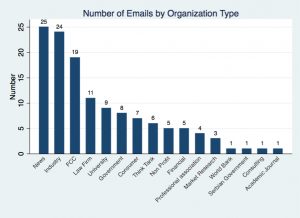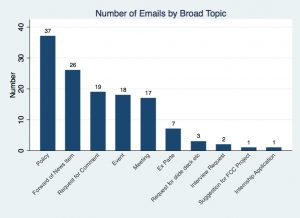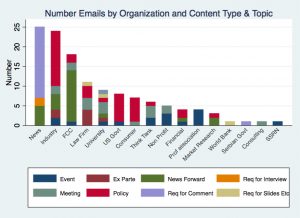Recently, Vice News received 623 pages of emails from the FCC in response to a Freedom of Information Act request. Vice News has kindly made the entire PDF file available for download.
We decided to categorize the emails to get a picture of who contacts the FCC and what they want to talk about. This simple categorization is time consuming given the need to review each page to pull out the relevant information. Nevertheless, our intrepid research associate, Nathan Kliewer, managed to slog his way through the pile, leaving us with a clean dataset. The fruits of his labor are printed below.
The statistics derived from this dataset come with important caveats. First, and most importantly, we categorize only the initial email in any given chain of emails. As a result, this analysis tells us nothing about the extent of a given email interaction. Second, it is possible that some emails are mischaracterized (seriously, you try reading 623 pages of blurry PDFs). Third, because the FCC released only selected emails, we do not know if these emails are representative of FCC email correspondence.
Nevertheless, let’s see what we’ve got.
Figure 1 shows the number of emails from different types of organizations.
Figure 1
The figure shows that most emails were initiated by news organizations, followed closely by industry. The FCC itself appears as the originator of a good number of these emails, most of which are from one FCC staff member to another. Eleven emails are from law firms (which represent industry clients), nine from people affiliated with universities, eight from other government agencies, seven from consumer advocacy groups, and six from think tanks. Among the unexpected emails is one from a representative of the government of Serbia simply inquiring about “current regulatory challenges,” and another from someone applying for an internship at the FCC (the latter we did not include in the figure).
Figure 2 highlights the general subject or topic of the email. The largest number of emails, not surprisingly, contains the sender’s views on policy issues relevant to net neutrality. The second largest number is news items people forward to FCC staff. Next are requests for comments, followed by information about events and requests for meetings.
Figure 2
Figure 3 combines these two categories to reveal which type of organizations focus on which issues. Industry, consumer groups, and other government agencies tend to send emails discussing views on policy issues. News organizations send requests for comments. Industry and law firms, generally representing industry, send ex parte notices.
Figure 3
Unfortunately, this meta-analysis tells us little about whether those emails mattered in any real way. I also can’t believe I spent so much time on this.
According to the Vice News story, the FCC plans on releasing more emails on November 26. I look forward to seeing an updated meta-analysis of those emails, but prepared by somebody else.





